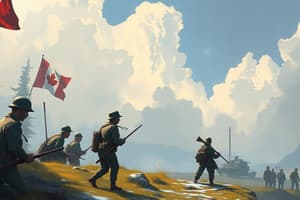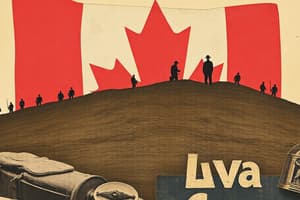Podcast
Questions and Answers
What was one of the primary contributions of early explorers like John Cabot and Jacques Cartier to Canada?
What was one of the primary contributions of early explorers like John Cabot and Jacques Cartier to Canada?
- They created Indigenous oral histories.
- They founded major Canadian cities.
- They established formal governments in Canada.
- They explored and mapped parts of Canada. (correct)
What does the acronym M.A.I.N stand for in relation to the causes of World War I?
What does the acronym M.A.I.N stand for in relation to the causes of World War I?
- Military, Allies, Indifference, National policies
- Mobilization, Alliances, Internal conflicts, Nationalism
- Might, Alliances, Imperialism, Nations
- Militarism, Alliances, Imperialism, Nationalism (correct)
What is the significance of Indigenous oral history?
What is the significance of Indigenous oral history?
- It serves primarily as fiction for entertainment.
- It only recounts events from the past century.
- It is based on modern scientific observations.
- It preserves cultural knowledge and community identity. (correct)
What was the purpose of the creeping barrage during World War I?
What was the purpose of the creeping barrage during World War I?
Which of the following best describes the nature of alliances prior to World War I?
Which of the following best describes the nature of alliances prior to World War I?
Which forces were primarily involved in the Battle of Ypres in 1915?
Which forces were primarily involved in the Battle of Ypres in 1915?
What was significant about the German army in the Somme battle of 1916?
What was significant about the German army in the Somme battle of 1916?
Which Canadian military unit was involved in significant operations at Vimy Ridge in 1917?
Which Canadian military unit was involved in significant operations at Vimy Ridge in 1917?
What event is marked by the signing of the armistice on November 11, 1918?
What event is marked by the signing of the armistice on November 11, 1918?
What was a major consequence of the Treaty of Versailles signed in 1919?
What was a major consequence of the Treaty of Versailles signed in 1919?
What was the primary purpose of the League of Nations?
What was the primary purpose of the League of Nations?
What impact did residential schools have on Indigenous communities in Canada?
What impact did residential schools have on Indigenous communities in Canada?
What was the primary objective of land acknowledgements?
What was the primary objective of land acknowledgements?
What event triggered the outbreak of World War I?
What event triggered the outbreak of World War I?
How many Canadians enlisted during World War I?
How many Canadians enlisted during World War I?
Which war measure enacted in 1914 allowed the government to exert greater control?
Which war measure enacted in 1914 allowed the government to exert greater control?
What was one significant outcome of Canada's participation in World War I?
What was one significant outcome of Canada's participation in World War I?
What psychological condition did many soldiers suffer from due to trench warfare?
What psychological condition did many soldiers suffer from due to trench warfare?
Which battle marked the first use of chemical weapons involving Canadian troops?
Which battle marked the first use of chemical weapons involving Canadian troops?
What issue arose due to the economic impact of the war in Canada?
What issue arose due to the economic impact of the war in Canada?
What was a notable achievement of Canada during the Hundred Days campaign in 1918?
What was a notable achievement of Canada during the Hundred Days campaign in 1918?
Flashcards
Indigenous Oral History
Indigenous Oral History
Traditional stories and teachings passed down through generations by Indigenous peoples.
The Creeping Barrage
The Creeping Barrage
A military tactic used in World War I where artillery fire moves forward in increments to provide cover for advancing infantry.
Alliances (Cause of WWI)
Alliances (Cause of WWI)
A complex system of treaties and alliances that obligated nations to defend each other, contributing to the escalation of conflicts leading to World War I.
Imperialism (Cause of WWI)
Imperialism (Cause of WWI)
Signup and view all the flashcards
Nationalism (Cause of WWI)
Nationalism (Cause of WWI)
Signup and view all the flashcards
Franz Ferdinand Assassination
Franz Ferdinand Assassination
Signup and view all the flashcards
Emergence of Canadian Identity
Emergence of Canadian Identity
Signup and view all the flashcards
Canadian Identity During WWI
Canadian Identity During WWI
Signup and view all the flashcards
Initial Canadian Support for WWI
Initial Canadian Support for WWI
Signup and view all the flashcards
Enlistment in WWI
Enlistment in WWI
Signup and view all the flashcards
War Measures Act
War Measures Act
Signup and view all the flashcards
Consequences of the War Measures Act
Consequences of the War Measures Act
Signup and view all the flashcards
Life in the Trenches
Life in the Trenches
Signup and view all the flashcards
Ypres (1915)
Ypres (1915)
Signup and view all the flashcards
Somme (1916)
Somme (1916)
Signup and view all the flashcards
Vimy Ridge (1917)
Vimy Ridge (1917)
Signup and view all the flashcards
Canada's Hundred Days (1918)
Canada's Hundred Days (1918)
Signup and view all the flashcards
Armistice (1918)
Armistice (1918)
Signup and view all the flashcards
Treaty of Versailles (1919)
Treaty of Versailles (1919)
Signup and view all the flashcards
League of Nations
League of Nations
Signup and view all the flashcards
British North America Act (1867)
British North America Act (1867)
Signup and view all the flashcards
Study Notes
The Spark - Franz Ferdinand's Assassination
- Franz Ferdinand, Archduke of Austria, was assassinated on June 28, 1914, in Sarajevo.
- The assassination was carried out by Gavrilo Princip, a Bosnian Serb nationalist.
- This triggered a series of events leading to World War I.
- Austria-Hungary declared war on Serbia.
- Allied nations also became involved in a chain reaction.
Canadian Identity Development
- Canadian identity solidified during the late 19th and early 20th centuries.
- Factors like immigration, language, and regional diversity influenced this.
- Participation in World War I fostered national pride and unity.
- Canadians fighting alongside British forces led to greater recognition of Canada's independence.
Canada's Role in World War I
- Many Canadians initially supported the war effort due to patriotism and duty.
- Over 600,000 Canadians enlisted.
- Recruitment drives and propaganda encouraged participation.
- The war stimulated the Canadian economy through munitions production, agriculture, and manufacturing.
- However, inflation and labor shortages also resulted.
- The War Measures Act was enacted in 1914, allowing the government to control the economy, society, and individuals to maintain national security.
- Censorship, internment of enemy aliens, and restrictions on civil liberties were some consequences.
Life in the Trenches During WWI
- Soldiers faced deplorable living conditions, including mud, vermin, and disease.
- Constant threat of enemy fire created significant stress and trauma.
- Shell shock (now known as PTSD) was a common condition suffered by many.
- Major battles included Ypres, Somme, Vimy Ridge, and Canada's Hundred Days.
Specific Battles (Further details)
- Ypres (1915): First major Canadian battle; use of chemical weapons.
- Somme (1916): One of the bloodiest battles, significant Canadian experience gained.
- Vimy Ridge (1917): Major Canadian victory, turning point in national identity.
- Canada's Hundred Days (1918): Series of offensives leading to the Allies' victory, showcasing Canada's military capabilities.
- Allied Forces: Primarily British Empire troops, including Canadian soldiers in Ypres.
- Allied Forces: British and French forces, with Canadian troops, in Somme.
- Allied Forces: Canadian Corps, made up of 4 divisions in Vimy Ridge.
- Allied Forces: Canadian Corps playing a crucial role in offensives in Canada's Hundred Days.
Treaty of Versailles
- In 1919, the Treaty of Versailles ended World War I.
- Germany was heavily penalized with reparations.
- European borders were redrawn.
- The League of Nations was established to prevent future conflicts.
League of Nations
- Founded as part of Treaty of Versailles.
- Aimed at promoting peace and cooperation among nations.
- However, it lacked enforcement power and failed to prevent aggression, which led to World War II.
British North America Act (Further details)
- Enacted in 1867.
- United Ontario, Quebec, New Brunswick, and Nova Scotia.
- Laid the foundation for Canadian Confederation.
- Provided a framework for Canadian governance.
Residential Schools
- Aimed at assimilating Indigenous children into Euro-Canadian culture.
- Operated from the late 19th to the mid-1990s.
- Led to cultural loss, trauma, and intergenerational effects on Indigenous communities.
Indigenous Oral History
- Traditional stories and teachings passed down through generations.
- Preserves cultural knowledge, values, and history.
- Important for education and community identity.
Main Causes of World War I (MAIN)
- Militarism: Arms race among nations.
- Alliances: Complex system of treaties escalating conflicts.
- Imperialism: Competition for colonies and resources.
- Nationalism: Strong national pride fueling independence desires.
The Creeping Barrage
- Military tactic of artillery fire proceeding infantry, providing cover and suppressing enemy defenses.
- Coordinated artillery and infantry movements.
- Mainly used in Vimy Ridge.
Studying That Suits You
Use AI to generate personalized quizzes and flashcards to suit your learning preferences.




